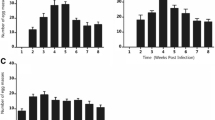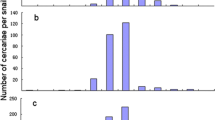Abstract
The objectives of this investigation were to assess the effect of temperature on the development of Schistosoma japonicum harboured in Oncomelania hupensis and to determine the lowest temperature threshold at which the hibernation of O. hupensis occurs. In the first experiment, adult infection-free O. hupensis, collected from Jiangsu province in eastern China, were infected with S. japonicum miracidia and raised at different temperatures under laboratory conditions. The development of miracidia until the release of cercariae was monitored employing the cercarial shedding method. In the second experiment, batches of O. hupensis were kept at temperatures below 13°C with the temperature gradually reduced. Snail activity was assessed by a pin puncture method. We found a positive relationship between the development of S. japonicum within O. hupensis and temperature. In snails kept at 15.3°C, S. japonicum arrested their development, while the fastest development occurred at 30°C. The temperature at which half of the snails were in hibernation (ET50) was 6.4°C. Our results underscore the pivotal role temperature plays on the biological activity of O. hupensis and the development of S. japonicum within the intermediate host. These findings are likely to have implications for the transmission of schistosomiasis in a warmer future China.


Similar content being viewed by others
References
Beggs PJ (2004) Impacts of climate change on aeroallergens: past and future. Clin Exp Allergy 34:1507–1513
Davis GM, Zhang Y, Guo YH, Spolsky CM (1995) Population genetics and systematic status of Oncomelania hupensis (Gastropoda: Pomatiopsidae) throughout China. Malacologia 37:133–156
Davis GM, Wilke T, Zhang Y, Xu XJ (1999) Snail–Schistosoma, Paragonimus interaction in China: population ecology, genetic diversity, coevolution and emerging diseases. Malacologia 41:355–377
Easterling DR, Meehl GA, Parmesan C, Changnon SA, Karl TR, Mearns LO (2000) Climate extremes: observations, modeling, and impacts. Science 289:2068–2074
Haines A, Kovats RS, Campbell-Lendrum D, Corvalan C (2006) Climate change and human health: impacts, vulnerability, and mitigation. Lancet 367:2101–2109
Hay SI, Cox J, Rogers DJ, Randolph SE, Stern DI, Shanks GD, Myers MF, Snow RW (2002) Climate change and the resurgence of malaria in the East African highlands. Nature 415:905–909
He YX (1993) Studies on the strain differences of Schistosoma japonicum in the mainland of China. XIII. Conclusion. Chinese Journal of Parasitology and Parasitic Diseases 11:93–97
Hunter PR (2003) Climate change and waterborne and vector-borne disease. J Appl Microbiol 94(Suppl):37S–46S
IPCC (2001) Climate change 2001: impacts, adaptation and vulnerability. Intergovernmental Panel on Climate Change. Cambridge University Press, Cambridge
Jiang YJ, Xi WP, Sun QQ (1997) The observation of mixed mud fodder for snail raising. Chinese Journal of Schistosomiasis Control 1:46–47
Knowlton K, Rosenthal JE, Hogrefe C, Lynn B, Gaffin S, Goldberg R, Rosenzweig C, Civerolo K, Ku JY, Kinney PL (2004) Assessing ozone-related health impacts under a changing climate. Environ Health Perspect 112:1557–1563
Liu YY (1993). Medical malacology. Ocean Press, Beijing
Malone JB, Zukowski SH (1992) Geographic models and control of cattle liver flukes in the southern USA. Parasitol Today 8:266–270
Mao CP (1990) Biology of schistosome and control of schistosomiasis. People’s Health Press, Beijing
Martens WJM, Jetten TH, Rotmans J, Niessen LW (1995) Climate change and vector-borne diseases: a global modeling perspective. Glob Environ Change 5:195–209
McMichael AJ, Woodruff RE, Hales S (2006) Climate change and human health: present and future risks. Lancet 367:859–869
MOH (1980) Complication of schistosomiasis research 1961–1979. Ministry of Health, Beijing, China
MOH (1982) Schistosomiasis prevention handbook. Science and Technique Press, Shanghai
Murphy JM, Sexton DM, Barnett DN, Jones GS, Webb MJ, Collins M, Stainforth DA (2004) Quantification of modelling uncertainties in a large ensemble of climate change simulations. Nature 430:768–772
Nagasaki M (1960) Studies on the development of Schistosoma japonicum larva within the snail host, Oncomelania nosophora, with special reference to temperature. Japanese Journal of Public Health 15:74–95
Pascual M, Ahumada JA, Chaves LF, Rodo X, Bouma M (2006) Malaria resurgence in the East African highlands: temperature trends revisited. Proc Natl Acad Sci USA 103:5829–5834
Patz JA, Campbell-Lendrum D, Holloway T, Foley JA (2005) Impact of regional climate change on human health. Nature 438:310–317
Pesigan TP, Hairston NG, Jauregui JJ (1958) Studies on Schistosoma japonicum infection in the Philippines. II. The molluscan host. Bull World Health Organ 18:481–578
Pflüger W (1980) Experimental epidemiology of schistosomiasis. I. The prepatent period and cercarial production of Schistosoma mansoni in Biomphalaria snails at various constant temperatures. Z Parasitenkd 63:159–169
Pflüger W, Roushdy MZ, El-Emam M (1983) Prepatency of Schistosoma haematobium in snails at different constant temperatures. J Egypt Soc Parasitol 13:513–519
Reiter P (2001) Climate change and mosquito-borne disease. Environ Health Perspect 109(Suppl 1):141–161
Rogers DJ, Randolph SE (2000) The global spread of malaria in a future, warmer world. Science 289:1763–1766
Ross AGP, Sleigh AC, Li YS, Davis GM, Williams GM, Jiang Z, Feng Z, McManus DP (2001) Schistosomiasis in the People’s Republic of China: prospects and challenges for the 21st century. Clin Microbiol Rev 14:270–295
Shao BR, Xu XJ (1956) Artificial infection of schistosome on Oncomelania. Chin Med J 42:357–359
Steinmann P, Keiser J, Bos R, Tanner M, Utzinger J (2006) Schistosomiasis and water resources development: systematic review, meta-analysis, and estimates of people at risk. Lancet Infect Dis 6:411–425
Storey KB, Storey JM (1990) Metabolic rate depression and biochemical adaptation in anaerobiosis, hibernation and estivation. Q Rev Biol 65:145–174
Sutherst RW (2004) Global change and human vulnerability to vector-borne diseases. Clin Microbiol Rev 17:136–173
Utzinger J, Zhou XN, Chen MG, Bergquist R (2005) Conquering schistosomiasis in China: the long march. Acta Trop 96:69–96
Wang TP, Johansen MV, Zhang SQ, Wang FF, Wu WD, Zhang GH, Pan XP, Ju Y, Ørnbjerg N (2005) Transmission of Schistosoma japonicum by humans and domestic animals in the Yangtze River valley, Anhui province, China. Acta Trop 96:198–204
Yang GJ, Vounatsou P, Zhou XN, Utzinger J, Tanner M (2005a) A review of geographic information system and remote sensing with applications to the epidemiology and control of schistosomiasis in China. Acta Trop 96:117–129
Yang GJ, Vounatsou P, Zhou XN, Tanner M, Utzinger J (2005b) A potential impact of climate change and water resource development on the transmission of Schistosoma japonicum in China. Parassitologia 47:127–134
Yang GJ, Gemperli A, Vounatsou P, Tanner M, Zhou XN, Utzinger J (2006) A growing degree–days based time-series analysis for prediction of Schiostsoma japonicum transmission in Jiangsu province, China. Am J Trop Med Hyg 75:549–555
Yiteng J (1986) Animal ecology study methods, Scientific Press
Zou ZL (1983) Ento-ecology. Science and Technique Press, Shanghai
Zhou XN, Hu XS, Sun NS, Hong QB, Sun LP, Lu G, Fuentes M, Malone JB (1999) Application of geographic information systems on schistosomiasis surveillance. II. Predicting transmission intensity. Chinese Journal of Schistosomiasis Control 11:66–70
Zhou XN, Yang GJ, Sun LP, Hong QB, Yang K, Wang RB, Hua ZH (2002a) Potential impact of global warming on the transmission of schistosomiasis. Chinese Journal of Epidemiology 23:83–86
Zhou XN, Cheng MG, McManus D, Bergquist R (2002b) Schistosomiasis control in the 21st century. Proceedings of the International Symposium on Schistosomiasis, Shanghai, July 4–6, 2001. Acta Trop 82:95–114
Zhou XN, Wang LY, Chen MG, Wu XH, Jiang QW, Chen XY, Zheng J, Utzinger J (2005) The public health significance and control of schistosomiasis in China—then and now. Acta Trop 96:97–105
Acknowledgements
Our sincere thanks are addressed to the staff of the Department of Schistosomiasis Control, Jiangsu Institute of Parasitic Diseases, China. This work received financial support from the UNICEF/UNDP/World Bank/WHO Special Programme for Research and Training in Tropical Diseases (TDR; project M8/181/4/Y.88, ID-A10775) and the Chinese National Science Foundation (project nos. 300070684 and 30590373). J. Utzinger and P. Vounatsou acknowledge the financial support from the Swiss National Science Foundation (project nos. PP00B-102883 and 3252B0-102136).
Author information
Authors and Affiliations
Corresponding author
Rights and permissions
About this article
Cite this article
Yang, GJ., Utzinger, J., Sun, LP. et al. Effect of temperature on the development of Schistosoma japonicum within Oncomelania hupensis, and hibernation of O. hupensis . Parasitol Res 100, 695–700 (2007). https://doi.org/10.1007/s00436-006-0315-8
Received:
Accepted:
Published:
Issue Date:
DOI: https://doi.org/10.1007/s00436-006-0315-8




